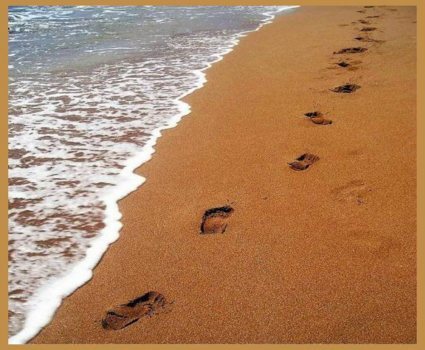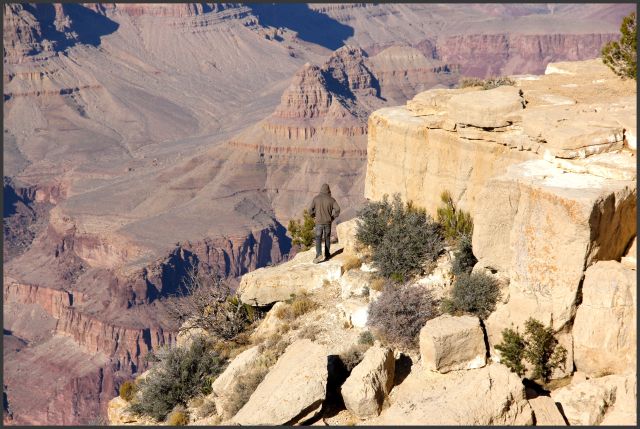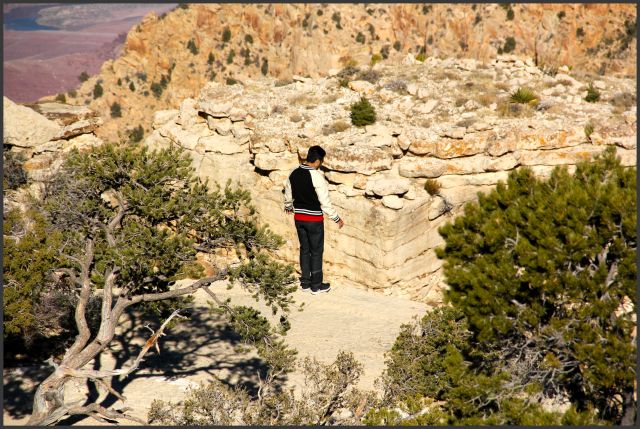Michael Ghiglieri (a world-reknown ecologist, highly experienced white-water (including the Colorado River through Grand Canyon) raft guide and Grand Canyon National Park Ranger) and Tom Myers (an accomplished backcountry hiker/route finder, physician at Grand Canyon Clinic for over a decade and current medical director to Grand Canyon National Park) co-authored the compelling book, Over the Edge: Death in Grand Canyon in their quest to determine which of the nearly 700 recorded traumatic fatalities since the late 1800's could have been prevented and how. The book focuses on deaths inside the canyon, not those on the plateau surrounding the canyon. It's also important to note that while the canyon extends far beyond the National Park boundaries into Indian reservations, private land and public land, most of the deaths have occurred within the current National Park boundaries which makes sense since that's where millions of tourists congregate every year.
People die in Grand Canyon every year - some are health related (like random heart attacks or illness-related) but most are preventable - falls, drowning, dehydration, hyper- or hypothermia and such. Webster's Dictionary defines "accident" as "an unforeseeable incident." Given that definition, Ghiglieri and Myers assert that "traumatic death in the Grand Canyon is rarely an accident" and that, in fact, nearly all such deaths are "the result of decisions made by the victim and/or those responsible for that victim's safety." Wow! It's tragic enough to lose a loved one but even worse when it could have been prevented.
Ghiglieri and Myers divide their book into sections such as falls from the rim, falls inside the canyon, suicides, drownings, flash floods, etc. Since I have never been down in the canyon (nope, not ever) this post is limited to falls (excluding suicide) from the rim and the foolish things we observed on our last trip to Grand Canyon.
I was not too surprised to learn that nearly a quarter (21%) of victims of lethal falls from the rim were either taking a photograph or posing for a photograph. Everyone wants to capture that "award-winning photo" but what shocked me was how many people in close proximity to the rim walk around paying no attention to where their feet are as they look through the viewfinder of their camera to get that perfect shot or who back up without looking behind them first. The flip side of that is posing for a photograph and let's face it, Grand Canyon offers some pretty spectacular backdrops. The problem is when folks walk around or climb over a guard rail or barricade to get just a little closer or to jump from rock to rock.
This girl (I'm guessing eighteen or twenty), after walking around a guard rail, jumped up and down while her mom took a photo of her from behind the guard rail. They were trying to get a photo with both of her feet off the ground. Her mom told her it would make "a great Facebook pic!" She is only about 18-inches from the edge and the drop is over 450 feet. Landing wrong on the loose gravel and slipping off the edge would not make for a happy photo.
Ghiglieri and Myers believe that most visitors to Grand Canyon have a 9-1-1 mentality meaning that if they are in trouble, they can simply dial 9-1-1 on their cell phone and help will immediately be available. This common notion is absolutely not true as cell service is spotty at best and rescue attempts can take hours or even days in inclement weather.
The authors of the book don't mention it, but I also wonder if people no longer have a healthy fear of dangerous situations due in part to playing video games and watching action movies where the "hero" goes through combat, a car crash or falls off a building with not so much as a scratch on his body.
This young man, after climbing over a guard rail, walked along a narrow ledge with a steep drop-off with his hands in his pockets. A slip on the loose gravel and he'd tumble down about 450 feet while he frantically tried to get his hands out of his pockets so he could grab something to stop his fall.
Another phenomenon mentioned by Ghiglieri and Myers is that looking down into such an immense hole like the Grand Canyon very often produces disorientation and clumsiness in otherwise sure-footed, agile individuals. This may be due to a lack of depth perception when peering down into the canyon producing a vertigo-like response. Even experienced NP rangers and guides have difficulty judging distance into the canyon from the rim with any accuracy.
This twenty-something guy "wins" the award for "Most Foolish Act." After climbing over a guard rail, he stood toe-to-rim with a vertical drop-off of over 100 feet. You can see him using his arms to maintain his balance. He stood there for less than a minute before backing up and walking away.
Not surprisingly, statistics reveal that 71% of rim fall victims are male and that the 20-29-year old age group is at greatest risk of falling off the rim. This is the same demographic that engages in risky behavior in other situations (like driving a car). With that said, more people have jumped or driven off the rims of Grand Canyon on purpose than have fallen off unintentionally.
"The only genuine safety and protection for us against an accidental fall at Grand Canyon resides in our own personal common sense and careful behavior. Common sense about personal safety cannot be legislated or insured by paved paths, warning signs, or guard rails. It must reside in the mind of the visitor."
~ Over the Edge: Death in Grand Canyon




No comments:
Post a Comment